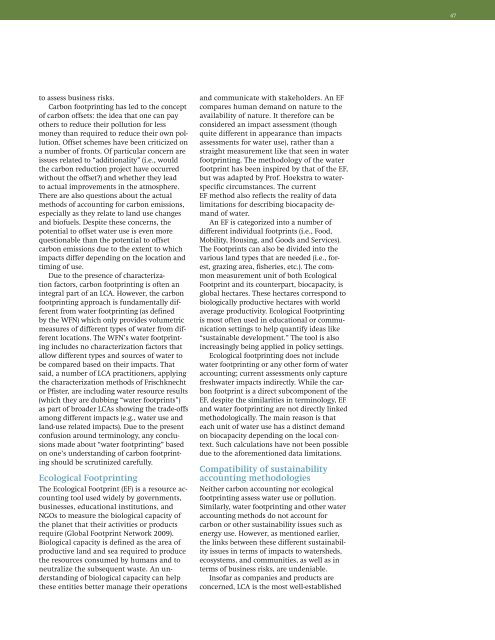Corporate Water Accounting: An Analysis of Methods and Tools for ...
Corporate Water Accounting: An Analysis of Methods and Tools for ...
Corporate Water Accounting: An Analysis of Methods and Tools for ...
You also want an ePaper? Increase the reach of your titles
YUMPU automatically turns print PDFs into web optimized ePapers that Google loves.
47<br />
to assess business risks.<br />
Carbon footprinting has led to the concept<br />
<strong>of</strong> carbon <strong>of</strong>fsets: the idea that one can pay<br />
others to reduce their pollution <strong>for</strong> less<br />
money than required to reduce their own pollution.<br />
Offset schemes have been criticized on<br />
a number <strong>of</strong> fronts. Of particular concern are<br />
issues related to “additionality” (i.e., would<br />
the carbon reduction project have occurred<br />
without the <strong>of</strong>fset?) <strong>and</strong> whether they lead<br />
to actual improvements in the atmosphere.<br />
There are also questions about the actual<br />
methods <strong>of</strong> accounting <strong>for</strong> carbon emissions,<br />
especially as they relate to l<strong>and</strong> use changes<br />
<strong>and</strong> bi<strong>of</strong>uels. Despite these concerns, the<br />
potential to <strong>of</strong>fset water use is even more<br />
questionable than the potential to <strong>of</strong>fset<br />
carbon emissions due to the extent to which<br />
impacts differ depending on the location <strong>and</strong><br />
timing <strong>of</strong> use.<br />
Due to the presence <strong>of</strong> characterization<br />
factors, carbon footprinting is <strong>of</strong>ten an<br />
integral part <strong>of</strong> an LCA. However, the carbon<br />
footprinting approach is fundamentally different<br />
from water footprinting (as defined<br />
by the WFN) which only provides volumetric<br />
measures <strong>of</strong> different types <strong>of</strong> water from different<br />
locations. The WFN’s water footprinting<br />
includes no characterization factors that<br />
allow different types <strong>and</strong> sources <strong>of</strong> water to<br />
be compared based on their impacts. That<br />
said, a number <strong>of</strong> LCA practitioners, applying<br />
the characterization methods <strong>of</strong> Frischknecht<br />
or Pfister, are including water resource results<br />
(which they are dubbing “water footprints”)<br />
as part <strong>of</strong> broader LCAs showing the trade-<strong>of</strong>fs<br />
among different impacts (e.g., water use <strong>and</strong><br />
l<strong>and</strong>-use related impacts). Due to the present<br />
confusion around terminology, any conclusions<br />
made about “water footprinting” based<br />
on one’s underst<strong>and</strong>ing <strong>of</strong> carbon footprinting<br />
should be scrutinized carefully.<br />
Ecological Footprinting<br />
The Ecological Footprint (EF) is a resource accounting<br />
tool used widely by governments,<br />
businesses, educational institutions, <strong>and</strong><br />
NGOs to measure the biological capacity <strong>of</strong><br />
the planet that their activities or products<br />
require (Global Footprint Network 2009).<br />
Biological capacity is defined as the area <strong>of</strong><br />
productive l<strong>and</strong> <strong>and</strong> sea required to produce<br />
the resources consumed by humans <strong>and</strong> to<br />
neutralize the subsequent waste. <strong>An</strong> underst<strong>and</strong>ing<br />
<strong>of</strong> biological capacity can help<br />
these entities better manage their operations<br />
<strong>and</strong> communicate with stakeholders. <strong>An</strong> EF<br />
compares human dem<strong>and</strong> on nature to the<br />
availability <strong>of</strong> nature. It there<strong>for</strong>e can be<br />
considered an impact assessment (though<br />
quite different in appearance than impacts<br />
assessments <strong>for</strong> water use), rather than a<br />
straight measurement like that seen in water<br />
footprinting. The methodology <strong>of</strong> the water<br />
footprint has been inspired by that <strong>of</strong> the EF,<br />
but was adapted by Pr<strong>of</strong>. Hoekstra to waterspecific<br />
circumstances. The current<br />
EF method also reflects the reality <strong>of</strong> data<br />
limitations <strong>for</strong> describing biocapacity dem<strong>and</strong><br />
<strong>of</strong> water.<br />
<strong>An</strong> EF is categorized into a number <strong>of</strong><br />
different individual footprints (i.e., Food,<br />
Mobility, Housing, <strong>and</strong> Goods <strong>and</strong> Services).<br />
The Footprints can also be divided into the<br />
various l<strong>and</strong> types that are needed (i.e., <strong>for</strong>est,<br />
grazing area, fisheries, etc.). The common<br />
measurement unit <strong>of</strong> both Ecological<br />
Footprint <strong>and</strong> its counterpart, biocapacity, is<br />
global hectares. These hectares correspond to<br />
biologically productive hectares with world<br />
average productivity. Ecological Footprinting<br />
is most <strong>of</strong>ten used in educational or communication<br />
settings to help quantify ideas like<br />
“sustainable development.” The tool is also<br />
increasingly being applied in policy settings.<br />
Ecological footprinting does not include<br />
water footprinting or any other <strong>for</strong>m <strong>of</strong> water<br />
accounting; current assessments only capture<br />
freshwater impacts indirectly. While the carbon<br />
footprint is a direct subcomponent <strong>of</strong> the<br />
EF, despite the similarities in terminology, EF<br />
<strong>and</strong> water footprinting are not directly linked<br />
methodologically. The main reason is that<br />
each unit <strong>of</strong> water use has a distinct dem<strong>and</strong><br />
on biocapacity depending on the local context.<br />
Such calculations have not been possible<br />
due to the a<strong>for</strong>ementioned data limitations.<br />
Compatibility <strong>of</strong> sustainability<br />
accounting methodologies<br />
Neither carbon accounting nor ecological<br />
footprinting assess water use or pollution.<br />
Similarly, water footprinting <strong>and</strong> other water<br />
accounting methods do not account <strong>for</strong><br />
carbon or other sustainability issues such as<br />
energy use. However, as mentioned earlier,<br />
the links between these different sustainability<br />
issues in terms <strong>of</strong> impacts to watersheds,<br />
ecosystems, <strong>and</strong> communities, as well as in<br />
terms <strong>of</strong> business risks, are undeniable.<br />
Ins<strong>of</strong>ar as companies <strong>and</strong> products are<br />
concerned, LCA is the most well-established
















